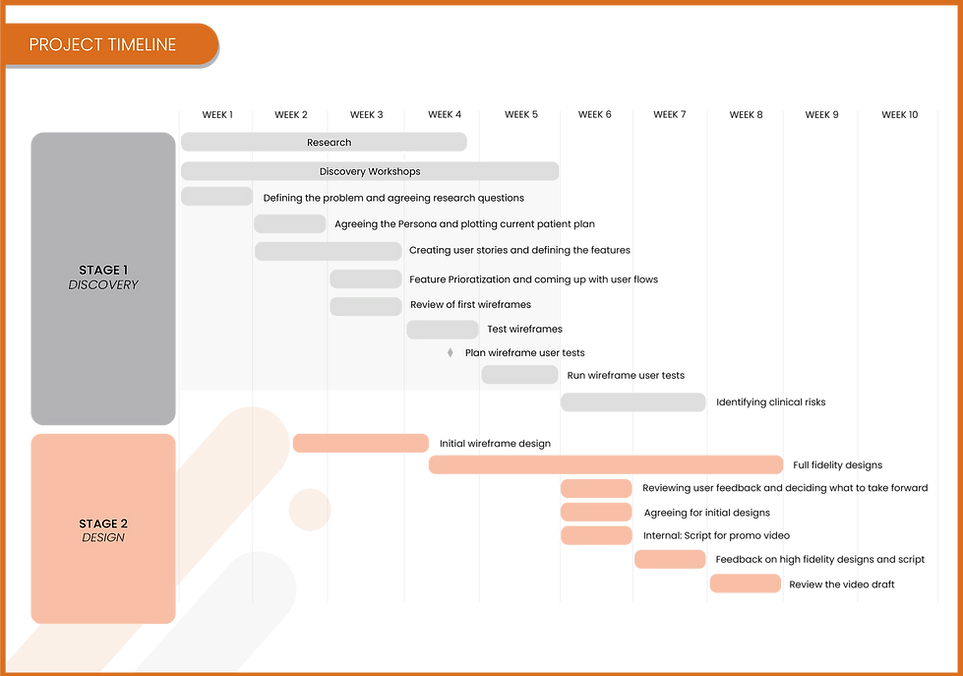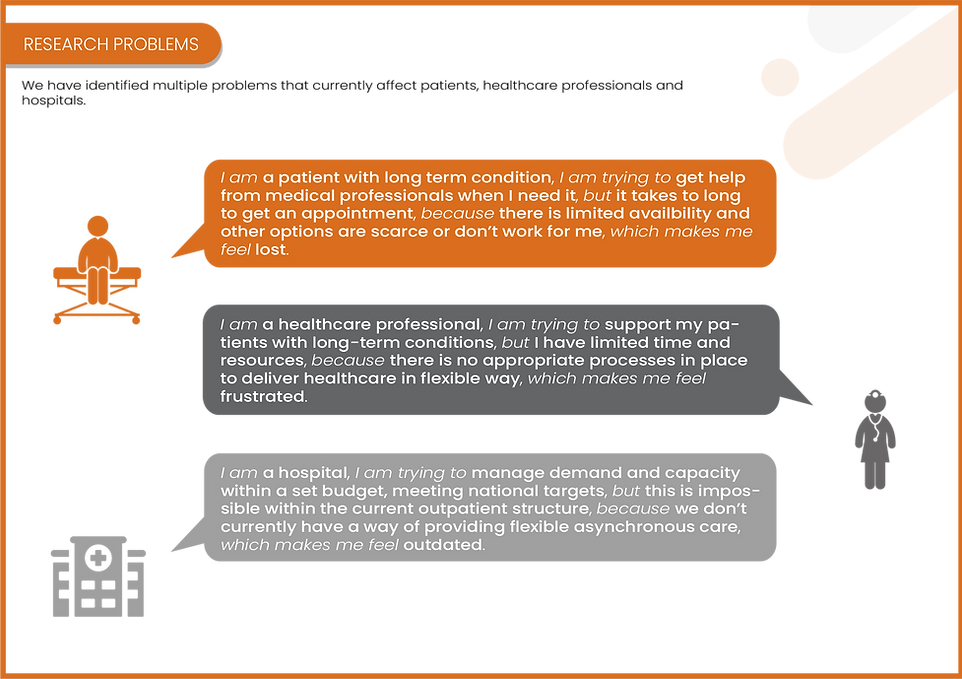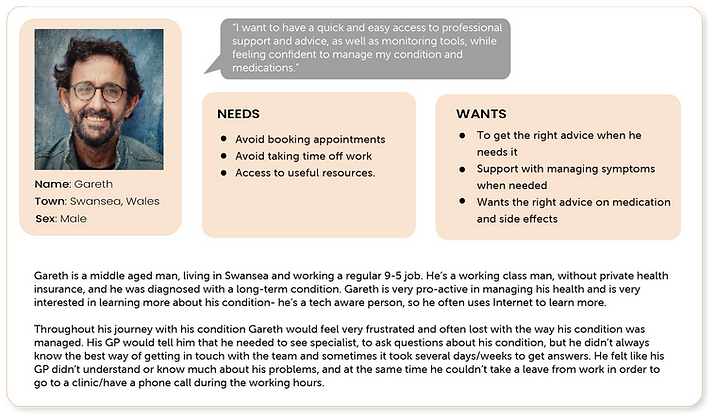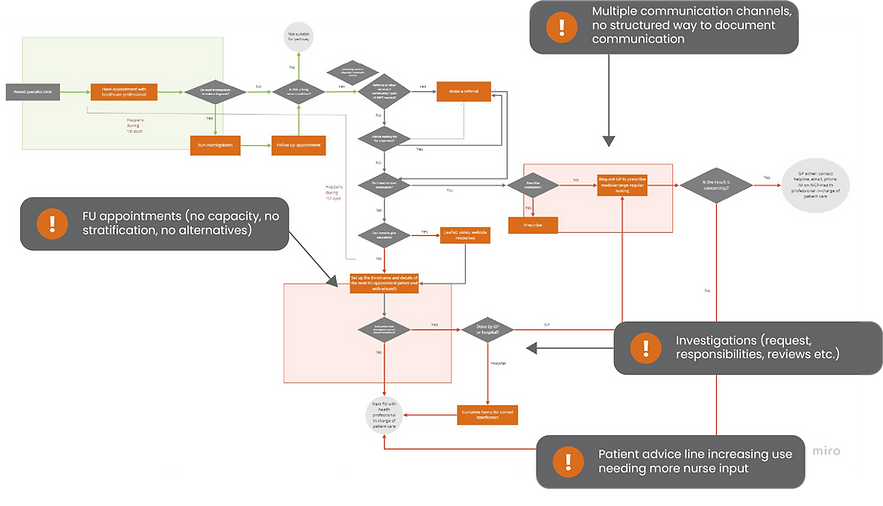Project Type
Research & Development
Tools
Figma
Miro
Adobe Illustrator
Duration
10 weeks (2022)
Methods
UX Workshop (Problem Discovery)
Primary Research (User interviews)
Data Analysis
User Persona
Complexity Quadrants
Wireframing
High-fidelity design
User Testing
Risk Analysis

PRODUCT OVERVIEW
About
Virtual Doctor* Is a digital solution designed to connect patients with healthcare experts. It has been deployed across the NHS, private and self-pay sectors. The product has a growing community of patients and healthcare professionals using it to deliver healthcare in a way that is safe and effective online.
*The product name has been changed to Virtual Doctor to maintain confidentiality and protect the identity of the real product.
Current functionality of Virtual Doctor includes:
-
Digital Triage | Configurable or Governance Controlled Standard
-
Video consultations | Simple, Secure, Recorded
-
Interoperable pathways | MSK triage, Virtual Dermatology, Ophthalmology
-
Automated data capture | Pre-assessment, Satisfaction and Outcome Reporting
PROJECT OVERVIEW
Goal
Due to the global pandemic and strain on medical staff, patients that need monitoring due to their condition are struggling to get appointments, and often do not have a way of seeking help from the right professional, at a time when it is needed the most. As part of SBRI Outpatient Transformation Challenge, the client has decided to expand the current possibilities of Virtual Doctor to support those patients throughout their ongoing health journey.
Mission
-
Provide patients and clinicians with a safe and effective way of managing their long-term condition online
-
Allowing patients to access help when they need it
-
Reducing strain on medical professionals

RESEARCH
Secondary research
During the initial workshops we have identified multiple research objectives that we were trying to answer throughout this project:
-
Research current functionality of Welsh Clinical Portal (WCP): Understand how widely it's used across Wales and explore possible API integrations with Virtual Doctor.
-
Investigate blood and imaging requests: Explore how different Health Boards in Wales request blood tests, x-rays, MRIs, and other images, as well as what systems are used for these requests.
-
Explore PROMs (Patient Reported Outcome Measures): Understand how PROMs are currently collected across Wales, what tools clinicians use, and what functionality would be required to make PROMs more responsive.
-
Identify variations in digital standards: Research any differences in digital healthcare standards between the UK and Wales.
-
Conduct a competitor analysis: Investigate products or services used for long-term disease surveillance and any PIFU (Patient Initiated Follow-Up) software being used in Wales.
-
Understand GP Connect usage: Find out how GP Connect is currently being used across Wales.

User persona
To keep us focused on making user-centered design decisions throughout the project, we created a user persona. This persona represented our target audience, showcasing their needs, goals, frustrations, and behaviors. By applying the persona at each stage of the design process, we were able to align our decisions with what would provide the most intuitive and rewarding experience for our users. It served as a constant reminder of who we are designing for, helping us prioritize features, navigation flows, and content that would best serve their needs.

Current pathway
As part of another workshop that included clinical and staff members of multiple Trust hospitals in Wales, we completed an activity to map a generic outpatient journey for patients with long term conditions and highlighted current pain points.

DESIGN
Solution ideation
During the solution ideation phase, we conducted a collaborative ideation workshop to generate a wide range of feature ideas that could address the key pain points of various user groups. As part of this process, we compiled a list of various features for multiple user groups and completed a ranking dot exercise to highlight desirable features, then combined this with a prioritisation matrix to determine the strategic developments. This approach allowed us to visually identify the most impactful and feasible solutions, ensuring that our design efforts were aligned with both user needs and business goals.

Features
Below is a list of key features that were agreed through the prioritisation and conversations with stakeholders:

Outcome
The proposed solution aimed to achieve the following benefits.
-
Reduced burden on the whole team
-
Communication Hub improving communication with everyone involved in patient care
-
Flagging patients for MDT attention and reporting on MDT meetings
-
Automated systems for investigation requests and monitoring notifications
-
Customization to suit different specialities
-
Advanced reporting functionality to support machine learning
Risks & Issues
As part of the project, we also identified and captured potential risks and challenges that could impact the success of the solution, allowing us to proactively address them and ensure a smoother development and implementation process.

OUTCOME
Lessons learned
To conclude the project, we gathered and documented key lessons learned throughout the process. We reflected on these insights to understand what worked well and what could be improved. This reflection allowed us to identify opportunities for future improvements and ensure that successful practices are carried forward into upcoming projects.
01 COLLABORATION
Challenge
Solution
Collaborative design is much more challenging when done virtually. You really miss the informal communication, rapport building, and interaction.
A mixture of in-person and remote sessions in the next project.
02 TECHNICAL ISSUES
Challenge
Solution
Miro interactive whiteboard worked well, but not all could access via hospital networks.
-
Ideally get the team onboarded before the project starts and allow time for them to do the online walkthrough on how to use the functionality.
-
Continue to provide an alternative as we did, using Teams chat and screen sharing.
03 TEAM INVOLVEMENT
Challenge
Solution
-
Unsure how much the team checked the weekly Teams updates and no integration on posts.
-
Some confusion at certain points as to what we were designing and what the overall objectives were.
-
Time at the beginning of the project perhaps setting expectations from the team.
-
Change session structure to do a look back / look forward exercise at the beginning of each new session to refresh everyone’s memory.
04 STRUCTURE
Challenge
Solution
Not enough time spent at the beginning doing in-depth qualitative interviews in small groups, but also including the wider team. Perhaps trying to bring clinicians along in the design process was not the best use of their time.
More structured approach in planning and involving the right stakeholders at the right time to avoid unnecessary involvement of clinicians.




